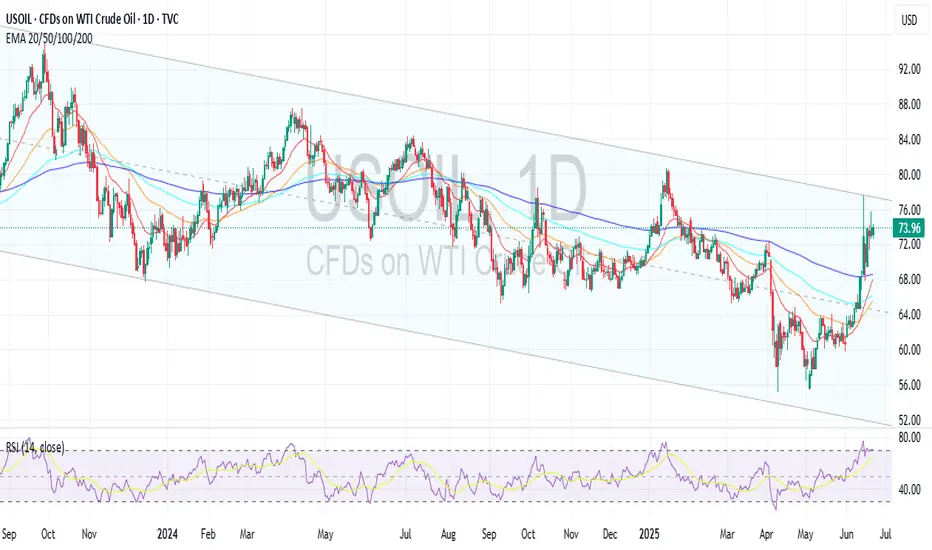USOIL may reach a saturation point and is likely to swing down, at least in the Short Term.
Analysis by: Krisada Yoonaisil, Financial Markets Strategist at Exness
- Technically, the price has tested the upper boundary of the descending channel near the key psychological resistance at $75 per barrel but failed to close above it, despite a brief breakout. This reflects the strength of the 75 resistance zone.
- Moreover, the RSI entered the overbought zone, and Bearish Divergence between price and RSI occured, which further increases the probability of a correction.
Therefore, at this stage, crude oil prices potentially pull back to the $70 level before determining the next directional move. - From a fundamental perspective, the recent surge in oil prices has been primarily driven by geopolitical tensions in the Middle East.
However, historically, the situation tends to cause only short-lived spikes in oil prices. Sustainable gains in oil prices require real demand support. Although the conflict persists, markets are less reactive, likely due to the absence of supply chain disruptions or transport route closures. - Additionally, the US decision to hold the strike and increase diplomat time has given investors time to adjust their portfolios, potentially for profit-taking from previously accumulated long positions.
As a result, oil prices may pull back during this period. - Now, considering the long-term factors, there are several reasons why oil prices are unlikely to rise significantly beyond The current levels:
- Oversupply:
Global crude oil production has been increasing, particularly from non-OPEC+ countries such as the United States, Canada, and Brazil. At the same time, OPEC+ members have been gradually raising their output as well, resulting in a market where supply exceeds demand. - Sluggish Demand Growth:
Oil demand is growing slowly due to a lackluster global economic outlook, the rising adoption of electric vehicles, and ongoing efforts to reduce fossil fuel consumption. Additionally, increasing risks such as new taxation and geopolitical tensions have led to investment slowdowns in certain regions. - Rising Inventories:
Global oil stockpiles have been steadily increasing, exerting downward pressure on prices. - Major entities have released their West Texas Intermediate (WTI) crude oil price forecasts for 2025 and 2026. J.P. Morgan projects prices at $66 per barrel for 2025 and $58 for 2026. The U.S. Energy Information Administration (EIA) offers a slightly different outlook, forecasting $62 per barrel in 2025 and $59 in 2026. Meanwhile, Trading Economics anticipates a price of $63.28 by the end of Q2 2025, rising to $65.70 in 2026.
Analysis by: Krisada Yoonaisil, Financial Markets Strategist at Exness
Disclaimer
The information and publications are not meant to be, and do not constitute, financial, investment, trading, or other types of advice or recommendations supplied or endorsed by TradingView. Read more in the Terms of Use.
Disclaimer
The information and publications are not meant to be, and do not constitute, financial, investment, trading, or other types of advice or recommendations supplied or endorsed by TradingView. Read more in the Terms of Use.
